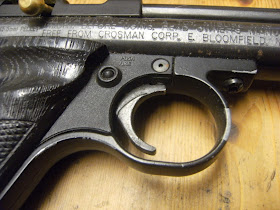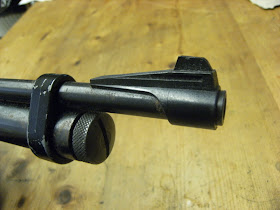 |
| That's 4.65 ft/lb on a cold winters day |
Costing under £100 quid, you could easily spend up to four times that on replacing parts and modding the gun to your own satisfaction which thousands of owners have done, turning out some rather splendid guns, some of which are nothing like the original.
 |
| My basic model, this one is over two years old and has had a lot of use. |
The pistol itself is a very simple design and one that Crosman and Benjamin have been using for many decades, though the 2240 is by far the sleekest model to date. It consists of a tube that holds the 12 gram Co2 and the 22XX valve, with a hammer and spring behind that and an end cap to hold it in place. The front end has a weighty knurled steel front cap which when screwed in pushes the Co2 cartridge against the valve to seal it. First shot will pierce the Co2 capsule, then it's ready to shoot pellets at it's full power.
 |
| The front cap needs only to be fairly finger tight, though there is a slot so it could be made tighter by using a penny or a screwdriver with a very large flat head. |
The trigger guard and pistol grip frame screw in with two screws from the underside; the pistol grips are ambidextrous with a thumb rest both sides which sweep back in the way that modern pistol grips do. It is just as comfortable to hold and shoot in either hand and the trigger, though quite thin, is a crescent moon shape and is surprisingly comfortable to use, a bit like one you would find on a PO8 or Luger (same thing really). The safety is built into the frame and blocks the trigger, a typical Crosman design.
 |
| A design that has been going for decades on many American air pistols. |
The breech is plastic and holds on with an Hex screw found in the loading tray, which itself is fairly spacious and loading pellets is a doddle.
 |
| Pellets just drop in, even these 25 gr Norica bullet shaped ones, and they are very long. |
The sealing O ring is found on the brass cocking bolt as is the way with the majority of single shot pneumatics.
 |
| Bolt probe with seal and a hex bolt that connects the plastic breech to the body. Can easily strip if not careful when removing it. |
The bolt handle is small but does the job, there is no spring but it locks into place in the L shaped slot on the right hand side, being only an annoyance to left handed people. The size, shape or material of the breech means there are no scope rails, though some scope mounts would bolt onto the 10 mm barrel if you want to scope the basic model. The Sheridan multi pump air rifles use the same block mounts.
 |
| Brass bolt and plastic breech, cheap but it does work. |
The barrel sits in the breech and is supported by an ali barrel band that is held in place with a grub screw and protrudes past the main tube of the body. It is cast and not of a high finish as you can clearly see the molding lines, same with the plastic breech as well.
 |
| The one grub screw is ample to secure the short barrel in place. |
Over the front end is a plastic ramped sight with a square post, which has a tendency to be knocked out of place at times.
 |
| The front sight which is not glued or heat shrunk in place and annoyingly moves, suppose its an easy way to adjust the windage. |
The rear sight is a flat piece of steel that screws into an adjustable plastic mount at the rear of the breech. Adjustment is made by loosening the screws and moving the sight to the desired position by small nudges then tightening again. I tend to find it annoying if truth be told, but on the bright side you can flip the rear sight upside down giving you the option of a square notch or a hole for a simple peep sight.
 |
| The rear sight, loosen screws, adjust to taste then tighten. Tight enough so they don't move when knocked, but not too tight so you strip the plastic that is in abundance here. |
At arms length the front post has a lot of space either side of it when viewed through the rear notch, so one could be smaller or the other a bit wider to increase accuracy. Practice can only improve your group sizes as you get use to the sights, a lot more practice in my case and a new glasses perscription as well!
The basic pistol is moddable in countless ways without even buying any extras. A small screw and hex kit, some small round files and a cheapo Dremel drill and you're away. Though there are countless companies out there that sell upgrade aftermarket parts, you could end up spending a large amount of money doing one up. Access to a lathe and milling machine will save you loads if you have the knowhow to use them, but most people will order all their upgrades from companies such as Gmac http://www.gmaccustomparts.com/ for the UK market. In the US, the Crosman company itself now offer their own design yourself 2240 as home modding has proved so popular.
 |
| The starting point for some of the wildest air rifle and pistol creations out there. |
Steel breech conversions are the most popular and make good sense as you can fit scope rings onto them; shiny brass replacement parts to bling up the pistol are another popular choice. With Gmac alone the possibilities are endless, with countless pistol grip designs, full stocks, extension barrels, conversion to HPA (high powered air, or something like that), muzzle breaks, power adjusters, shiny barrel bands and bits and bobs in brass or many adonised colours. As I say, the choice is never ending. If you look at the Ratcatcher Crosman 2250 which is being sold for 200 quid at the moment , you will find it's just the same valve, hammer, spring and tube as the 2240 pistol, but with a steel breech for mounting scope rings, a plastic fore stock and shoulder stock, and an 18 inch barrel which knocks the power up to 10 ft/lb from 6 ft/lb. As it is not a pistol any longer but a carbine rifle you can get it up to 12 ft/lb will a little fettling, I have heard of FAC versions of 60ft/lb which with a larger bore, a long barrel, and a bit of valve and transfer port fettling is entirely believable.
The best conversion i've seen to date is one where it's made to look an AR 15, but it's all down to personal taste and it's only imagination that can limit any creation based on the 2240 chassis. But I like the basic model, it is accurate and is very comfortable to hold and shoot and fun. I have often taken it with me when taking the dogs on a walk around the woods where I can shoot, just shooting stones off walls or hitting small branches and leaves keeps my simple mind happy.
TTFN
Keep safe and warm, Wing Commander Sir Nigel Tetlington-Smythe

















